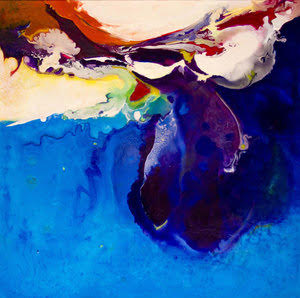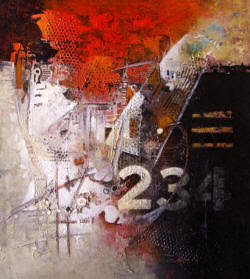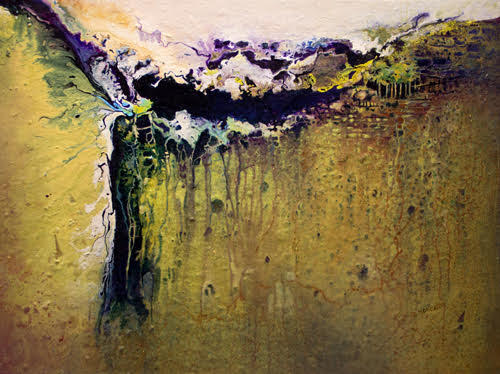Pouring Acrylic Abstract Painting With Luminosity & High Contrast
Jo Moncrief
Jo Moncrief
Pouring Acrylic Abstract Painting With Luminosity & High Constrast
April 3 - 6
10:00 AM - 4:30 PM
$400
Class Description:
The focus of this workshop is on ways to create abstract acrylic paintings that have visual interest, excitement and drama. Jo will be demonstrating (twice daily) on yupo or canvas. Each painting will begin as a wet into wet pouring of colors. This method allows colors to explode, mingle and blend with each other - creating magical, unique and unpredictable effects.
There will be daily exercises to help with the comprehension of the subject matter. The emphasis will be for each student to understand the steps in creating abstract art & complete as many paintings as possible during the workshop.
Jo will explain how she uses composition, color, values, principles & elements of design, contrast and the rule of thirds while working through a painting to finality. She will demonstrate the advantages of a limited palette (see supply list below), the Munsell Color Wheel vs. the traditional color wheel and how grays enhance any painting. There will be strong emphasis on how to use color as a value and the surprising benefits of learning how to read paint labels. Jo will also teach the importance of understanding the bias of colors and how they affect your palette and the importance of a focal point.
Artist’s Statement:
I am a self-taught artist. I have taken painting and ceramics courses in college, workshops and classes from artists whose artwork I admire. I paint or draw every day. I can do realistic artwork, impressionism, cubism, abstract and non-objective. By far, the most mentally challenging artwork is abstracts and non-objective painting.
I am not a gambler with money, but I like to treat my art like poker - a series of contemplated risks and a good chance for a jackpot now and then. It is impossible to not put a piece of yourself in your artwork. Each contact with the surface of the painting is a decision on your part, a move, a color added, a tilt of the canvas. Each of these can bring great success or near disaster.
I begin each painting as a wet into wet pouring of colors. This method allows colors to explode, mingle and blend with each other - creating magical, unique and unpredictable effects that simply cannot be painted by hand. Allowing the paint to flow, I use composition, hues, values, principles and elements of design, contrast and the rule of thirds while working through a painting to finality.
Each painting sits in a dark area of my home for days, weeks or longer to study and look at it in different lighting. This helps in determining any changes that need to be made.
Upon completion, my artwork is sealed in a UV polymer varnish that protects the surface from dust and dirt and helps to prevent fading due to ultraviolet radiation.
My paintings have received awards in many juried exhibitions and juried art festivals. In 2016, two of my paintings, Turbulence & Tranquility and Searching for What was, were accepted into North Light Books’ fourth annual Best of Acrylic competition AcrylicWorks 4: Captivating Color! The book was released in May, 2017. The artwork accepted in the book (quote from Publisher) “shows excellence and originality in acrylic paint achieved via a variety of styles and subjects. “
Supply List:
Artist and/or Student grade paints/hues- tubes/jars/liquid paints all work equally well in this workshop. Jo uses mainly student grade tube paints & hues and a few fluid acrylics. Any major brand like Liquitex, Liquitex Basics, Golden, etc.
Jo buys most of her supplies through www.jerrysartarama.com - or www.cheapjoes.com – be sure to allow 2 weeks or more for ordering. -Alizarin Crimson (hue only) or Quin Magenta (or both) – Jo prefers both –
Colors-
-Liquitex Brilliant Blue – best Cerulean blue color
-Cadmium Red Medium hue
-Cadmium Yellow Pale or Hansa Yellow Light – look for single pigment PY3
-Cad Yellow medium, Orange Yellow Azo, or Diarylide yellow -look for single pigment PY83
-Dioxazine purple
-Mars black and titanium white
-Metallic gold and silver - OR craft store metallics work well– **
-Pthalo Green (blue)
-Pthalo Blue (green)
-Ultramarine Blue
Liquitex Pouring Medium – 1 quart or larger – do not buy Golden Pouring Medium – Liquitex only – essential for pouring paints – try to order from Jerry's or Cheap Joe's – best prices
Liquitex Gloss Medium & Varnish – OPTIONAL - one pint or more – Jo will show how to use this in thin, transparent glazes of color that can alter the value or tone.
** please note – it is not imperative that you buy the above paints but you will see the best results if you do so.
-Bring any of your personal favorite paints also – Jo will demonstrate how to mix your favorite paints from the limited palette above
-Plastic bottles for pouring & storing paints – prefer bottles with spouts – optional - but srecommended – 6-12 bottles - Sam's has good large plastic spout bottles - Item # 595530 – in restaurant supplies – can be found in Beauty Supply stores also. These can be found online also at different restaurant and art suppliers.
Brushes - your preference but suggest watercolor style brushes or synthetic sable in 1/2” to 1-1/2” and then some finer brushes for detail. Don't bring bristle brushes,
-Watercolor Paper, Yupo, canvas – your choice –
-Canvas - suggest 8” to 12” canvas for daily exercises (Jo will demonstrate only on canvas or yupo) – up to 24” for personal paintings
-Yupo (preferred) or watercolor paper – minimum of 5 full sheets or more of lightweight yupo for daily exercises. Your weight preference for watercolor paper. Many exercises will be done on yupo.
2 large spray bottles for:
-Distilled Water – OPTIONAL - for mixing large amounts of paint (5-8 oz) otherwise tap water is fine – your choice
-Alcohol 70% is my preference - 90% can “burn” a hole in the paints at certain points of drying & should be used within limits
-1 pkg. plastic paint scrapers (found in tile department of Lowe’s & Home Depot) - 3 sizes in a pkg.
-Small plastic bowls– white only - bowls/plates or Styrofoam bowls/plates for mixing and pouring paints. There are great HDPE plastic bowls at some Dollar Trees – 3 cereal bowls for $1.00. These are not always available but excellent when found. Jo will provide one or more (depending on availability) for each student. No colors other than white please.
-Paper towels, scissors
OPTIONAL:
-Disposable gloves to work in – this is a request but not mandatory but is a good habit to form when painting
-Stencils, stamps, etc, – for making interesting marks
-Bring old acrylic or watercolor paintings that are not working – you must be willing to paint over these paintings – these make a great base to create new artwork.
-Jo will demonstrate using the Pat Dews Atomizer – expensive but worth the price , rubber color shaper, watercolor crayons, etc. - if time permits



